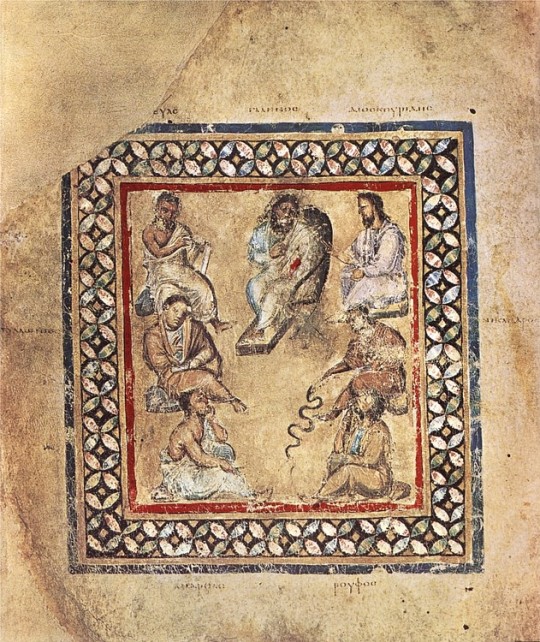#AntoninePlague
Explore tagged Tumblr posts
Photo

Galen
Galen (129-216 CE) was a Greek physician, author, and philosopher, working in Rome, who influenced both medical theory and practice until the middle of the 17th century CE. Owning a large, personal library, he wrote hundreds of medical treatises including anatomical, physiological, pharmaceutical, and therapeutic works. With principles based on his anatomical dissections, he spoke and wrote extensively on the anatomy of the body emphasizing the role of the heart, brain, and blood. While he criticized many of his contemporaries, he embraced the ideas put forth by the Greek physician and theorist Hippocrates (460-370 BCE), primarily his concept of the four humours that controlled the human condition: blood, phlegm, black bile, and yellow bile.
Much of our knowledge of early medicine comes from Galen's writings. Like Hippocrates and other theorists Galen believed that illness was caused by an imbalance, so how does one restore the balance: bleeding, enemas, and vomiting. Aside from his writings on medicine, he wrote extensively on language, logic, psychology, ethics, and even moral philosophy. Regrettably, most of his works no longer exist or survive only in fragments. He lost many of his writings, instruments, and medicines in a storeroom fire in 192 CE.
Early Life & Education
Born in 129 CE in the Asia Minor city of Pergamon, Galen was the son of the wealthy architect Nikon and was initially educated in both rhetoric and philosophy. The Pergamon of his youth was home to a sanctuary dedicated to the god of medicine Asclepius. His father, a member of the Roman elite, had assisted in the renovation of Pergamon's temple complex dedicated to Zeus. At the age of 16, Galen changed educational directions, possibly at the suggestion of his father, and decided to study medicine, eventually completing his schooling at both Smyrna, located on the Aegean coast, and Alexandria where he studied both anatomical science and physiological theory. At the time Alexandria was the premier center for the study of medicine in the ancient world. After the death of his father in 149/50 CE, he continued his studies as he traveled throughout the Mediterranean. In 157 CE he returned to his home town of Pergamon to be the physician to a group of gladiators; a position that provided him with an opportunity to study anatomy.
Continue reading...
61 notes
·
View notes
Photo

#TBT: Today we recognize #Galen of #Pergamon (129 AD - 210 AD), better known simply as Galen. Galen was a Greek physician, surgeon, and philosopher whose work profoundly affected the development of #anatomy, #physiology, #pathology, #pharmacology, and #neurology as well as #philosophy and #logic. Galen's anatomical studies included the #dissection of monkeys and pigs and his conclusions and subsequent theories would influence Western medical #science for more than 1,300-years. His experiments using animal models lead him to greater understanding of the circulatory, nervous, muscular, and respiratory systems. Galen, in fact, was the first to describe the anatomy of the #trachea and he was the first to demonstrate that the human voice is produced in the #larynx by which we give a big #BiologyCoachOnline #SHOUTOUT to Galen of Pergamon. #biophiles #biology #throwbackthursday #HippocraticOath #vivisection #bloodletting #Hippocrates #Rome #AntoninePlague #smallpox #biologyrulz
0 notes
Video
Deadliest Diseases in History of Humans - Most Dangerous Disease in the World
10. Plague of Athens (Ethiopia) - 429 BC 9. Antonine Plague (Europe) - 165 8. SARS (China) - 2003 7. Cholera (India) - 1816 6. Third Pandemic (China) - 1850 5. Smallpox (North America) - 1775 4. Plague of Justinian (Europe) - 541 3. Giant White Plague (Europe) - 1600 2. Black Death (Central Asia) - 1348 1. The Spanish flu (USA) - 1918
#rarediseaseslist #mostdeadlydiseases #listofcommondiseases #mostcommondiseasesintheworld #listofdeadlydiseases #deadliestdiseasesinhistory #deadliestdiseaseintheworld #listofdiseasesinhumans #worstdiseasesinhistory #mostdangerousdiseaseintheworld #PlagueofAthens #AntoninePlague #SARS #Cholera #ThirdPandemic #Smallpox #PlagueofJustinian #GiantWhitePlague #BlackDeath #TheSpanishflu
https://youtu.be/5pDs375REDg
0 notes
Video
List of Deadly Diseases in Humans History - Most Common Diseases in the World 10. Plague of Athens (Ethiopia) - 429 BC 9. Antonine Plague (Europe) - 165 8. SARS (China) - 2003 7. Cholera (India) - 1816 6. Third Pandemic (China) - 1850 5. Smallpox (North America) - 1775 4. Plague of Justinian (Europe) - 541 3. Giant White Plague (Europe) - 1600 2. Black Death (Central Asia) - 1348 1. The Spanish flu (USA) - 1918 #rarediseaseslist #mostdeadlydiseases #listofcommondiseases #mostcommondiseasesintheworld #deadlydiseaseswithoutcure #listofdeadlydiseases #deadliestdiseasesinhistory #worstdiseaseintheworld #deadliestdiseaseintheworld #listofdiseasesinhumans #mostdangerousdiseaseintheworld #PlagueofAthens #AntoninePlague #SARS #Cholera #ThirdPandemic #Smallpox #PlagueofJustinian #GiantWhitePlague #BlackDeath #TheSpanishflu https://youtu.be/TkKXevxRbcQ
0 notes